A BowTie is a diagram that visualizes the risk you are dealing with in just one, easy to understand picture. The diagram is shaped like a bow tie, creating a clear differentiation between proactive and reactive risk management.
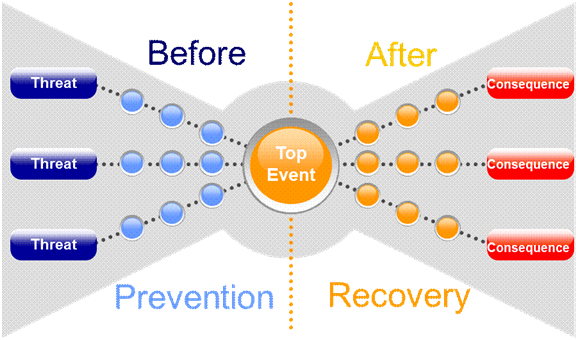
The power of a BowTieXP diagram is that it gives you an overview of multiple plausible scenarios, in a single picture. In short, it provides a simple, visual explanation of a risk that would be much more difficult to explain otherwise. While the power of BowTie is that it is very easy to understand for everybody, from top management to shop floor, developing a good BowTie is a completely different story. It requires a good knowledge of the BowTie concept, an understanding of the guidelines and how to apply them and a good overview of the subject that is being assessed.
There are 3 phases in the development of a BowTie:
1. Understanding the Risk
 Hazard
Hazard
The start of any BowTie is the Hazard. A hazard is something in, around or part of the organization that has the potential to cause damage. Working with hazardous substances, driving a car or storing sensitive data are examples of hazards.
Top Event
Once the hazard is chosen, the next step is to define the Top Event. This is the moment when control is lost over the hazard. There is no damage or negative impact yet, but it is imminent. This means that the top event is chosen just before events start causing actual damage.
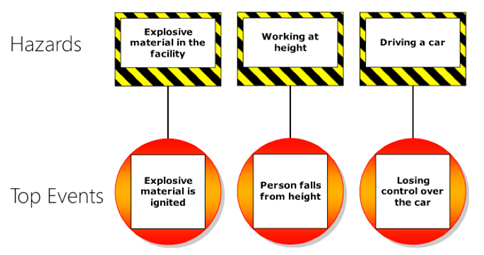
Threats
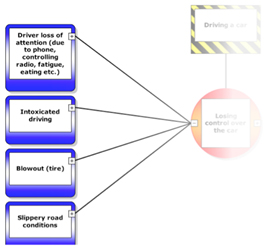 Threats are whatever will cause your top event. There can be multiple threats. Try to avoid generic formulations like human error, equipment failure or weather conditions. What does a person actually do to cause the top event? Which piece of equipment? What kind of weather or what does the weather impact?
Threats are whatever will cause your top event. There can be multiple threats. Try to avoid generic formulations like human error, equipment failure or weather conditions. What does a person actually do to cause the top event? Which piece of equipment? What kind of weather or what does the weather impact?
.
.
Consequences
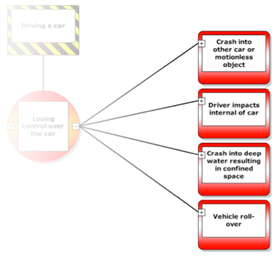 Consequences are the result from the top event. There can be more than one consequence for every top event. Try not to focus on injury/fatality, asset damage, environmental damage, reputation damage or financial damage. Those are broader categories of damage rather than specific consequence event descriptions. Try to describe events like a car roll-over, oil spill into sea or toxic cloud.
Consequences are the result from the top event. There can be more than one consequence for every top event. Try not to focus on injury/fatality, asset damage, environmental damage, reputation damage or financial damage. Those are broader categories of damage rather than specific consequence event descriptions. Try to describe events like a car roll-over, oil spill into sea or toxic cloud.
.
.
The picture so far
At this stage we have a clear understanding of the risk and what needs to be controlled. The Hazard, Top Event, Threats and Consequences give us an overview about everything we don’t want around a certain Hazard.
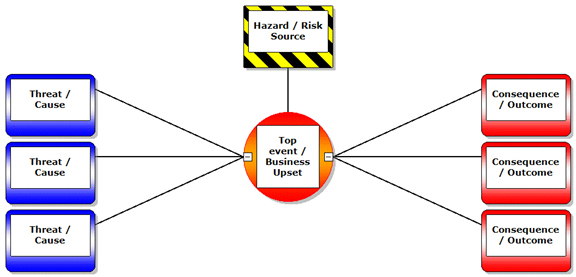
2. Controlling the Risk
Control and Recovery Barriers
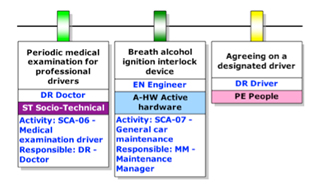 Barriers in the BowTie appear on both sides of the Top Event. Barriers interrupt the scenario so that the threats do not result in a Loss of Control (the Top Event) or do not escalate into an actual impact (the consequences).
Barriers in the BowTie appear on both sides of the Top Event. Barriers interrupt the scenario so that the threats do not result in a Loss of Control (the Top Event) or do not escalate into an actual impact (the consequences).
There are different types of barriers, which are mainly a combination of human behavior and/or hardware/ technology. Once the barriers are identified, you have a basic understanding about how risks are managed. Barrier visuality can be selected to include barrier types, barrier effectiveness, responsible persons and a host of other categories. This lets you assess how well barriers perform. After that you can look at the activities you have to implement and maintain you barriers. Also determining who is responsible for a barrier and assessing the criticality of a barrier are things you can do to increase your understanding of the barriers.

3. Understanding the Weaknesses of the Control Framework
Escalation Factors & Escalation Factor barriers
 Barriers are never perfect. Even the best hardware barrier can fail. Given this fact, what you need to know is why a barrier will fail. This is done using the Escalation Factor. Anything that will make a barrier fail can be described in an escalation factor. For instance, a door that opens and closes automatically using an electrical mechanism might fail if there’s a power failure.
Barriers are never perfect. Even the best hardware barrier can fail. Given this fact, what you need to know is why a barrier will fail. This is done using the Escalation Factor. Anything that will make a barrier fail can be described in an escalation factor. For instance, a door that opens and closes automatically using an electrical mechanism might fail if there’s a power failure.
The logical next step to manage escalation factors is to create barriers for you escalation factors, aptly named escalation factor barriers. In this case it could be a seat belt awareness campaign.
The complete diagram
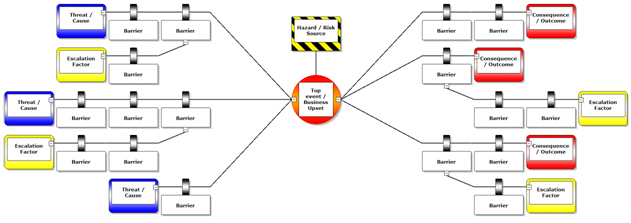
Besides the basic BowTie diagram, management systems should also be considered and integrated with the BowTie to give an overview of what activities keep barriers working and who is responsible for each barrier. Integrating the management system into a BowTie demonstrates how hazards are managed by a company. The BowTie can also be used effectively to assure that hazards are managed to an acceptable level (ALARP).
 Hazard
Hazard


